 Civil War II #5 (of 8) — Writer: Brian Michael Bendis; Art: David Marquez; Art Assist: Sean Izaakse; Colors: Justin Ponsor
Civil War II #5 (of 8) — Writer: Brian Michael Bendis; Art: David Marquez; Art Assist: Sean Izaakse; Colors: Justin Ponsor
Patsy Walker, A.K.A. Hellcat #10 — Writer: Kate Leth; Art: Brittney Williams; Colors: Megan Wilson
The Mighty Thor #11 — Writer: Jason Aaron; Art: Russell Dauterman; Colors: Matthew Wilson
The Vision #11 (of 12) — Writer: Tom King; Art: Gabriel Hernandez Walta; Colors: Jordie Bellaire
 Amazing Spider-Man #18 — Writer: Dan Slot; Pencils: R. B. Silva; Inks: Adriano di Benedetto; Colors: Marte Gracia
Amazing Spider-Man #18 — Writer: Dan Slot; Pencils: R. B. Silva; Inks: Adriano di Benedetto; Colors: Marte Gracia
The Punisher #5 — Writer: Becky Cloonan; Art: Steve Dillon; Colors: Frank Martin
International Iron Man #7 (of 7) — Writer: Brian Michael Bendis; Art: Alex Maleev; Colors: Paul Mounts
Seven Marvels, seven DCs and seven independent titles, so let’s take them one big group at a time: Civil War II is kind of lumbering along, big event mini-series that it is, already late and having added an eighth issue to its back end (now due out the last week of 2016). This week’s installment helps to show why: it involves lots of big-screen fighting, with  various Avengers, X-Men, Inhumans, Ultimates, Guardians and pretty much everyone else squared off against each other as part of the mix; the dozens and dozens of characters must have taken Marquez, a careful and detailed artist, forever to draw. Fortunately, it’s energetic, and even goofy, fun, with quips flying and various powers on colorful display — right up until Ulysses, the future-casting Inhuman, has a vision of things to come that involves… well, you’ll have to see, but it stops everyone in their tracks, and promises to drive many of the tie-in comics for the next few months, at least. If you’re just concerned with the main series (which, let’s face it, if you’re a Marvel fan you pretty much have to buy), the good news is that the other six Marvel books on this list are not tie-ins; they’re all involved in independent storylines right now. Hellcat is about as far away from the hyper-
various Avengers, X-Men, Inhumans, Ultimates, Guardians and pretty much everyone else squared off against each other as part of the mix; the dozens and dozens of characters must have taken Marquez, a careful and detailed artist, forever to draw. Fortunately, it’s energetic, and even goofy, fun, with quips flying and various powers on colorful display — right up until Ulysses, the future-casting Inhuman, has a vision of things to come that involves… well, you’ll have to see, but it stops everyone in their tracks, and promises to drive many of the tie-in comics for the next few months, at least. If you’re just concerned with the main series (which, let’s face it, if you’re a Marvel fan you pretty much have to buy), the good news is that the other six Marvel books on this list are not tie-ins; they’re all involved in independent storylines right now. Hellcat is about as far away from the hyper-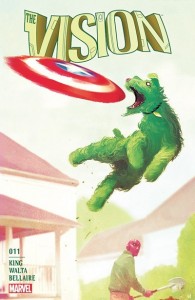 realism of Civil Wars II as it’s possible to be, with cartoony manga-ish flourishes from Williams, whose style clicks confidently into place this issue and gels with Leth’s tale of Patsy’s two ex-boyfriends (they even called them her “evil exes” last issue, in a hip little shout-out to Scott Pilgrim) sending her to hell, and everyone battling to get her back. In other hands, that would be grim and gritty, but here it’s a cheerful tribute to friendship and spunkiness not letting the world get you down; despite some insider-baseball continuity, this comic has moved right up there with Squirrel Girl as a great entry-level gift for younger and newer readers — and a pleasure for older ones, too. Mighty Thor is a lot more mainstream-superhero, but very well done, with the twist still that Thor is, you know, a girl — a woman, actually, and a very brave and noble one, well-suited to the battles against the various evils, both cosmic and earth-bound, that she’s forced to fight. Aaron offers a plot that’s a canny blend of the traditional and the modern,
realism of Civil Wars II as it’s possible to be, with cartoony manga-ish flourishes from Williams, whose style clicks confidently into place this issue and gels with Leth’s tale of Patsy’s two ex-boyfriends (they even called them her “evil exes” last issue, in a hip little shout-out to Scott Pilgrim) sending her to hell, and everyone battling to get her back. In other hands, that would be grim and gritty, but here it’s a cheerful tribute to friendship and spunkiness not letting the world get you down; despite some insider-baseball continuity, this comic has moved right up there with Squirrel Girl as a great entry-level gift for younger and newer readers — and a pleasure for older ones, too. Mighty Thor is a lot more mainstream-superhero, but very well done, with the twist still that Thor is, you know, a girl — a woman, actually, and a very brave and noble one, well-suited to the battles against the various evils, both cosmic and earth-bound, that she’s forced to fight. Aaron offers a plot that’s a canny blend of the traditional and the modern, 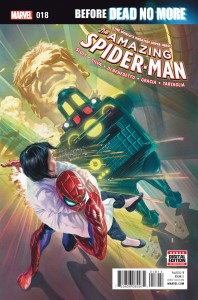 while Dauterman handles everything thrown at him, from minotaur CEOs to comic-relief S.H.I.E.L.D agents to the cancer-stricken Jane Foster, with his skillful knack for making all of it both good-looking and believable. The twist-ending answer to the cover’s Clark Kent/Superman-like question — how can Thor and Foster be in the same place at the same time? — is both clever and startling, one of those game-changers that this team tosses off with casual grace. Meanwhile, The Vision keeps tossing off its own game-changers, as the series’ penultimate issue sees the scarlet synthezoid fighting through the Avengers to exact revenge for the “death” of his self-manufactured son by yet another member of the humanoid-machine community, as his carefully-constructed suburban-family lifestyle keeps crumbling around him. Great eye-catching cover, which sums up the comic’s blend of creepily-off-kilter picket-fence family life — with superhero elements mixed in — just perfectly. Amazing Spider-Man is much more
while Dauterman handles everything thrown at him, from minotaur CEOs to comic-relief S.H.I.E.L.D agents to the cancer-stricken Jane Foster, with his skillful knack for making all of it both good-looking and believable. The twist-ending answer to the cover’s Clark Kent/Superman-like question — how can Thor and Foster be in the same place at the same time? — is both clever and startling, one of those game-changers that this team tosses off with casual grace. Meanwhile, The Vision keeps tossing off its own game-changers, as the series’ penultimate issue sees the scarlet synthezoid fighting through the Avengers to exact revenge for the “death” of his self-manufactured son by yet another member of the humanoid-machine community, as his carefully-constructed suburban-family lifestyle keeps crumbling around him. Great eye-catching cover, which sums up the comic’s blend of creepily-off-kilter picket-fence family life — with superhero elements mixed in — just perfectly. Amazing Spider-Man is much more 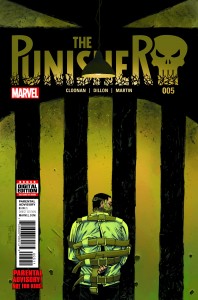 traditional superhero stuff, but always well-done, from the Alex Ross cover to the return of the title character’s second-most-iconic villain to the way all the subplots bubble under the surface, preparing the way for future events even as the current action unspools. The Punisher is similarly-canny in knowing what its audience wants, and what works best with its hard-boiled, vengeance-delivering main character: Becky Cloonan’s disturbingly good at creating the requisite sociopaths for him to fight, and choreographing the resulting mayhem, and of course Steve Dillon always delivers his signature calm, clear-eyed view of the depraved goings on (no one draws people getting their faces detached — and those faces themselves — quite like him; he’s been doing it since his Preacher days, and Cloonan’s wise to give him an opportunity to demonstrate that facility here, too). That leaves International Iron Man, an origin story about how Tony Stark’s parents — not the Starks, since he was adopted — met, involving ’80s pop-punk music, spies
traditional superhero stuff, but always well-done, from the Alex Ross cover to the return of the title character’s second-most-iconic villain to the way all the subplots bubble under the surface, preparing the way for future events even as the current action unspools. The Punisher is similarly-canny in knowing what its audience wants, and what works best with its hard-boiled, vengeance-delivering main character: Becky Cloonan’s disturbingly good at creating the requisite sociopaths for him to fight, and choreographing the resulting mayhem, and of course Steve Dillon always delivers his signature calm, clear-eyed view of the depraved goings on (no one draws people getting their faces detached — and those faces themselves — quite like him; he’s been doing it since his Preacher days, and Cloonan’s wise to give him an opportunity to demonstrate that facility here, too). That leaves International Iron Man, an origin story about how Tony Stark’s parents — not the Starks, since he was adopted — met, involving ’80s pop-punk music, spies 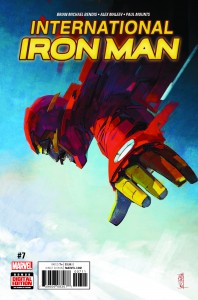 working for S.H.I.E.L.D. and Hydra, and betrayal. No Iron Man at all in the issue — making that cover a bait-and-switch, a pet peeve of mine — and it’s fortunate that Alex Maleev is so great at drawing people standing around talking, because that’s pretty much all that’s here (to be fair, they’re also sometimes shooting one another, or stabbing each other in the neck with scissors), but it’s got some effective emotional beats, especially at the end, and offers an important addition to the Iron Man mythos and supporting cast, so this wrap-up issue, especially, is worth a look.
working for S.H.I.E.L.D. and Hydra, and betrayal. No Iron Man at all in the issue — making that cover a bait-and-switch, a pet peeve of mine — and it’s fortunate that Alex Maleev is so great at drawing people standing around talking, because that’s pretty much all that’s here (to be fair, they’re also sometimes shooting one another, or stabbing each other in the neck with scissors), but it’s got some effective emotional beats, especially at the end, and offers an important addition to the Iron Man mythos and supporting cast, so this wrap-up issue, especially, is worth a look.
 Trinity #1 — Writer/Artist/Colors: Francis Manapul
Trinity #1 — Writer/Artist/Colors: Francis Manapul
Superman #7 — Story: Peter J. Tomasi and Patrick Gleason; Art: Jorge Jimenez; Colors: Alejandro Sanchez
Raven #1 (of 6) — Writer: Marv Wolfman; Art: Alisson Borges; Colors: Blond
Cyborg #1 — Writer: John Semper Jr.; Pencils: Paul Pelletier; Inks: Tony Kordos and Scott Hanna; Colors: Guy Major
Batman #7 — Writer: Steve Orlando; Co-Plotter: Tom King; Art: Riley Rossmo; Colors: Ivan Plascencia
 Nightwing #5 — Writer: Steve Orlando; Co-Plotter: Tim Seeley; Art: Roge Antonio; Colors: Chris Sotomayor
Nightwing #5 — Writer: Steve Orlando; Co-Plotter: Tim Seeley; Art: Roge Antonio; Colors: Chris Sotomayor
Lucifer #10 — Writer: Holly Black; Art: Lee Garbett; Colors: Antonio Fabela and Veronica Gandini
The week’s batch of DC books: Trinity brings the company’s Big Three — Superman, Batman, Wonder Woman — together, as Lois invites the latter two over to dinner with her newly-public husband and son (since “their” Superman has died, and they don’t know much about this new/old one). Manapul, both writer and artist, sets up the trio’s uneasy but  growing friendship with a plot that looks like it’s going to involve their origins; artistically, he’s got a light touch with faces — everybody looks a little ethereal, especially when in their civilian identities — but then switches to a more solid and dramatic style once they’re in costume. with at least one decent splash to showcase each icon. Hard to tell quite where this is going yet, but it’s off to a decent start. Superman #7, like Trinity, establishes the new rural small-town reality for Clark, Lois and Jon — it’s a coda to the book’s initial six-issue arc with the Eradicator, and a slice-of-life tale where Clark spends a day out of costume, taking his family to the county fair; as the best of these kinds of stories do, it establishes the family’s relationships, with each other and with the new supporting cast, and offers a
growing friendship with a plot that looks like it’s going to involve their origins; artistically, he’s got a light touch with faces — everybody looks a little ethereal, especially when in their civilian identities — but then switches to a more solid and dramatic style once they’re in costume. with at least one decent splash to showcase each icon. Hard to tell quite where this is going yet, but it’s off to a decent start. Superman #7, like Trinity, establishes the new rural small-town reality for Clark, Lois and Jon — it’s a coda to the book’s initial six-issue arc with the Eradicator, and a slice-of-life tale where Clark spends a day out of costume, taking his family to the county fair; as the best of these kinds of stories do, it establishes the family’s relationships, with each other and with the new supporting cast, and offers a 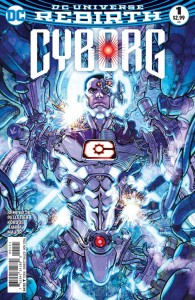 number of quiet moments, with a last-page splash that’s just right. Jimenez has to do a lot in that scene just with expressions, and he nails each one, from Clark and Jon’s joy to Lois’s comic anger; if you want to get a feel for the Man of Steel’s new status quo, this book is a good place to start. Raven is the first of a six-issue series starring the emo Titan, as she moves in with her aunt and uncle in San Francisco, goes to a new high school, finds it hard to fit in and encounters a mysterious girl with powers. All pretty standard, but done well: Raven’s creator, Marv Wolfman, is the writer, and he’s been doing this a long time; he has a firm handle on the character’s Goth-girl personality (think Ally Sheedy in The Breakfast Club,
number of quiet moments, with a last-page splash that’s just right. Jimenez has to do a lot in that scene just with expressions, and he nails each one, from Clark and Jon’s joy to Lois’s comic anger; if you want to get a feel for the Man of Steel’s new status quo, this book is a good place to start. Raven is the first of a six-issue series starring the emo Titan, as she moves in with her aunt and uncle in San Francisco, goes to a new high school, finds it hard to fit in and encounters a mysterious girl with powers. All pretty standard, but done well: Raven’s creator, Marv Wolfman, is the writer, and he’s been doing this a long time; he has a firm handle on the character’s Goth-girl personality (think Ally Sheedy in The Breakfast Club,  or Winona Ryder in Beetlejuice) and knows just which plot buttons to push to make it all work. Cyborg‘s writer, John Semper Jr., on the other hand, is brand-new to comics, but he’s had a long career in TV animation (he produced the ’90s Spider-Man: The Animated Series), so he’s not really a rookie. This debut, taken with the Cyborg: Rebirth one-shot from s couple weeks ago, looks to be setting up one of those “Am I really human?” conflicts for Vic (the title of the first six-issue arc is “Imitation of Life”); that’s a well-traveled road for this character, but a logical one, and it’s underlined with a decent scene in a jazz club, just before the inevitable super-villain shows up. The art’s OK; Pelletier’s one of those artists who doesn’t call attention to himself with showy effects, but is always able to keep the story flowing smoothly and clearly: a meat-and-potatoes guy on a meat-and-potatoes
or Winona Ryder in Beetlejuice) and knows just which plot buttons to push to make it all work. Cyborg‘s writer, John Semper Jr., on the other hand, is brand-new to comics, but he’s had a long career in TV animation (he produced the ’90s Spider-Man: The Animated Series), so he’s not really a rookie. This debut, taken with the Cyborg: Rebirth one-shot from s couple weeks ago, looks to be setting up one of those “Am I really human?” conflicts for Vic (the title of the first six-issue arc is “Imitation of Life”); that’s a well-traveled road for this character, but a logical one, and it’s underlined with a decent scene in a jazz club, just before the inevitable super-villain shows up. The art’s OK; Pelletier’s one of those artists who doesn’t call attention to himself with showy effects, but is always able to keep the story flowing smoothly and clearly: a meat-and-potatoes guy on a meat-and-potatoes 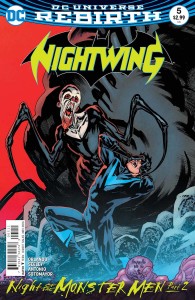 (and metal…) character, so a good match. The week’s two Bat-family books are the first parts of a six-part crossover, Night of the Monster Men, that’s been building in the background for a couple of months. Batman itself gets the first chapter, with regular writer Tom King handing most of the reins over to Steve Orlando, and guest art by up-and-comer Riley Rossmo (last seen on Constantine, and on his own indy book, Drumheller), whose slightly-surreal style lends itself to the outsized horror-movie creations who start attacking Gotham, spurred on by one of the Dark Knight’s oldest foes. Nightwing provides the continuation, with more monsters and Blackgate Prison getting added to the mix; this is trying to be revved-up B-movie fun, and it’s got an OK start, although we’ll have to see the other installments before we can tell whether it’s going to stick the landing
(and metal…) character, so a good match. The week’s two Bat-family books are the first parts of a six-part crossover, Night of the Monster Men, that’s been building in the background for a couple of months. Batman itself gets the first chapter, with regular writer Tom King handing most of the reins over to Steve Orlando, and guest art by up-and-comer Riley Rossmo (last seen on Constantine, and on his own indy book, Drumheller), whose slightly-surreal style lends itself to the outsized horror-movie creations who start attacking Gotham, spurred on by one of the Dark Knight’s oldest foes. Nightwing provides the continuation, with more monsters and Blackgate Prison getting added to the mix; this is trying to be revved-up B-movie fun, and it’s got an OK start, although we’ll have to see the other installments before we can tell whether it’s going to stick the landing 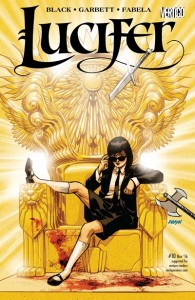 or fizzle out. That leaves Lucifer, which accelerates away from the TV series and towards the original comic’s cosmic spectacle in earnest this issue, as God, having been murdered and reincarnated as decidedly more Old Testament-y than before, threatens our cast, who end up fleeing the universe entirely and encountering a couple of familiar-to-old-readers characters. Writer Holly Black’s taking a lot of cues from original series scribe Mike Carey here, and does a good job of duplicating his combination of outsize mythology and humanistic, deadpan tone; that, and the striking cover, make it feel like the book never left.
or fizzle out. That leaves Lucifer, which accelerates away from the TV series and towards the original comic’s cosmic spectacle in earnest this issue, as God, having been murdered and reincarnated as decidedly more Old Testament-y than before, threatens our cast, who end up fleeing the universe entirely and encountering a couple of familiar-to-old-readers characters. Writer Holly Black’s taking a lot of cues from original series scribe Mike Carey here, and does a good job of duplicating his combination of outsize mythology and humanistic, deadpan tone; that, and the striking cover, make it feel like the book never left.
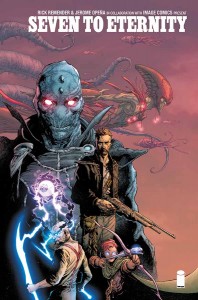 Seven to Eternity #1 — Writer: Rick Remender; Art: Jerome Opena; Colors: Matt Hollingsworth
Seven to Eternity #1 — Writer: Rick Remender; Art: Jerome Opena; Colors: Matt Hollingsworth
The Simpsons Treehouse of Horror #22 — Creators: Various
She-Wolf #4 — Creator: Rich Tommaso
The Wicked and the Divine: 1831 one-shot — Writer: Kieron Gillen; Art/Colors: Stephanie Hans
Dept.H #6 — Writer/Artist: Matt Kindt; Colors: Sharlene Kindt
 Archie #12 — Writer: Mark Waid; Breakdowns: Ryan Jamploe; Finishes: Thomas Pitilli; Colors: Andre Szymanowicz
Archie #12 — Writer: Mark Waid; Breakdowns: Ryan Jamploe; Finishes: Thomas Pitilli; Colors: Andre Szymanowicz
I Hate Fairyland #9 — Writer/Artist: Skottie Young; Colors: Jean-Francois Beaulieu
The one new indy book, Seven to Eternity, is from Rick Remender and Jerome Opena, who’ve been collaborating a long time — they did Strange Girl and Fear Agent for Image a decade ago, before moving to Marvel and working on volumes of Punisher and X-Force. Now they’re back at Image, and this new series is sf/fantasy, 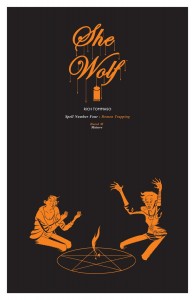 set in a world of magic where the son of a family of exiles must confront the tyrant who drove them away years ago. In Remender’s world, no one’s ever a textbook hero — everyone struggles with their dark and light impulses, and the right thing to do is neither obvious nor easy — and Opena’s art reflects that shadowy dilemma, with widescreen shots of the dark alien landscape (there’s a double-page spread that’s meant to be awe-inspiring, and is) and precise, intimate close-ups of the hardscrabble principle characters, both grim and beautiful; if you like that style of work, this is a top-tier example of it. The Simpsons Treehouse of Horror takes the ghostly and the grim and puts an opposite spin on it, with bigfoot comedy: this
set in a world of magic where the son of a family of exiles must confront the tyrant who drove them away years ago. In Remender’s world, no one’s ever a textbook hero — everyone struggles with their dark and light impulses, and the right thing to do is neither obvious nor easy — and Opena’s art reflects that shadowy dilemma, with widescreen shots of the dark alien landscape (there’s a double-page spread that’s meant to be awe-inspiring, and is) and precise, intimate close-ups of the hardscrabble principle characters, both grim and beautiful; if you like that style of work, this is a top-tier example of it. The Simpsons Treehouse of Horror takes the ghostly and the grim and puts an opposite spin on it, with bigfoot comedy: this 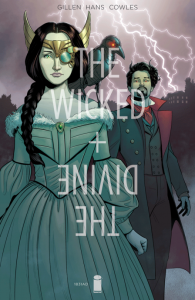 annual Hallowe’en book is still going strong after 22 years. There’s a Ghostbusters parody (of course there is…) by Tony Digerolamo, Rex Lindsey and Patrick Owsley; an X-Files one involving giant, murderous cafeteria food by Ian Boothby, Tone Rodriguez and Andrew Pepoy; a vampire infestation at Grandpa Simpson’s retirement home by James Bates, Phil Ortiz and Mike Rots; and a Looney Tunes tribute by Terry Delegeane and Jacob Chabot — all manage the usual effective combination of the creepy and the comic, with lots of semi-scary fun. “Scary fun” applies to She-Wolf, too, although its werewolf tale is more eerie and hallucinatory than
annual Hallowe’en book is still going strong after 22 years. There’s a Ghostbusters parody (of course there is…) by Tony Digerolamo, Rex Lindsey and Patrick Owsley; an X-Files one involving giant, murderous cafeteria food by Ian Boothby, Tone Rodriguez and Andrew Pepoy; a vampire infestation at Grandpa Simpson’s retirement home by James Bates, Phil Ortiz and Mike Rots; and a Looney Tunes tribute by Terry Delegeane and Jacob Chabot — all manage the usual effective combination of the creepy and the comic, with lots of semi-scary fun. “Scary fun” applies to She-Wolf, too, although its werewolf tale is more eerie and hallucinatory than  humorous, with demons and vampires and lycanthropes all in bloody conflict, and rendered in Tommaso’s semi-woodcut style: it’s a gorgeous-looking book. The Wicked and the Divine: 1831 offers a one-shot look at a previous incarnation cycle of the regular title’s gods, from the Romantic Era of the early 1800’s, giving Gillen a chance to imagine the rock stars of that day — writers like Byron, both Shelleys, Keats, Poe and others — as the tragically-doomed avatars; it also gives him a chance to work with Stephanie Hans, whose painterly forms and pastel colors are much different than regular artist Jamie McKelvie’s clear, cool lines, but
humorous, with demons and vampires and lycanthropes all in bloody conflict, and rendered in Tommaso’s semi-woodcut style: it’s a gorgeous-looking book. The Wicked and the Divine: 1831 offers a one-shot look at a previous incarnation cycle of the regular title’s gods, from the Romantic Era of the early 1800’s, giving Gillen a chance to imagine the rock stars of that day — writers like Byron, both Shelleys, Keats, Poe and others — as the tragically-doomed avatars; it also gives him a chance to work with Stephanie Hans, whose painterly forms and pastel colors are much different than regular artist Jamie McKelvie’s clear, cool lines, but 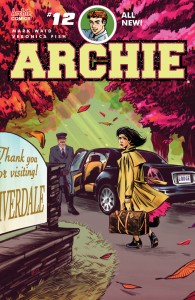 perfect for the Gothic, long-ago setting. Over in Dept.H, Matt Kindt has unique art, too, somehow both sketchy and precise, and combining it with Sharlene Kindt’s watercolors makes this bottom-of-the-sea murder mystery as mysterious and haunting as the depths in the title pun; its main character, investigating the death of her scientist father, is an appealing and stubborn truth-seeker, as the best detective heroes are. Archie reaches the end of its second volume, with the romantic soap-opera elements more prominent than the comic ones, as various relationships fracture and shift: writer Waid offers the usual smooth ride and dead-on characterization (the book’s reprint section has a story he wrote when he was
perfect for the Gothic, long-ago setting. Over in Dept.H, Matt Kindt has unique art, too, somehow both sketchy and precise, and combining it with Sharlene Kindt’s watercolors makes this bottom-of-the-sea murder mystery as mysterious and haunting as the depths in the title pun; its main character, investigating the death of her scientist father, is an appealing and stubborn truth-seeker, as the best detective heroes are. Archie reaches the end of its second volume, with the romantic soap-opera elements more prominent than the comic ones, as various relationships fracture and shift: writer Waid offers the usual smooth ride and dead-on characterization (the book’s reprint section has a story he wrote when he was  on-staff with Archie Comics 25 years ago, with Moose hulking out, that shows how long he’s been doing this), and makes this modern take on the Riverdale gang click. That leaves I Hate Fairyland, Skottie Young’s piss-take of the kids’-lit trope of a quest through an enchanted kingdom, with buckets of ultra-cartoony ultra-violence, almost R-rated dialogue (“muffin-huggers” is a favorite epithet) and pretty darned hilarious shenanigans for incipient sociopaths of all ages. It’s not a book that you’d want your grandmother to look at too closely… and that’s exactly the point.
on-staff with Archie Comics 25 years ago, with Moose hulking out, that shows how long he’s been doing this), and makes this modern take on the Riverdale gang click. That leaves I Hate Fairyland, Skottie Young’s piss-take of the kids’-lit trope of a quest through an enchanted kingdom, with buckets of ultra-cartoony ultra-violence, almost R-rated dialogue (“muffin-huggers” is a favorite epithet) and pretty darned hilarious shenanigans for incipient sociopaths of all ages. It’s not a book that you’d want your grandmother to look at too closely… and that’s exactly the point.



